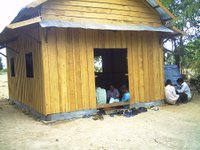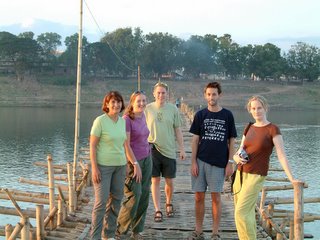
Everyone talks about “Capacity Building” out here, even Cambodian people who don’t speak English! My role at CoDeC is to help build the capacity of the staff. In turn, the staff aim to build the capacity of poor rural villagers. The main way that CoDeC tries to build villager capacity is through holding endless workshops for them! One village, Spien Krong, has been selected as a “model community fishery”, meaning that it is getting extra resources (thanks to Oxfam GB via CoDeC) and training to help it to manage and govern itself. A committee has been elected in the village, regular meetings are held, there is a united approach against illegal fishing, savings and credit groups have been set up and support for developing alternative and cooperative livelihoods is provided. This hut (see picture) has been newly built to provide a centre for all these activities – there’s no electricity, windows, door, furniture, water or toilet, but it’s a lot more than the village used to have. CoDeC is running three 2-day workshops in Spien Krong over a two week period, covering business awareness, financial awareness and animal raising! Villagers are given $1.50 per day to attend, which is probably more than they’d earn fishing. Some of the information covered is extremely basic, and also somewhat inappropriate for poorly educated fishing people, but they all seem to enjoy attending. I have pages of feedback to give to my colleagues on how they could improve the workshops, although I’m not sure how receptive they will be to this. I am also asked to give presentations at the workshops (using my translator, of course!), but these are difficult and probably not very useful, as the language and cultural context is so different from what I’m used to. However, the villagers seem to like the novelty of having an English person talking to them!
 Everyone talks about “Capacity Building” out here, even Cambodian people who don’t speak English! My role at CoDeC is to help build the capacity of the staff. In turn, the staff aim to build the capacity of poor rural villagers. The main way that CoDeC tries to build villager capacity is through holding endless workshops for them! One village, Spien Krong, has been selected as a “model community fishery”, meaning that it is getting extra resources (thanks to Oxfam GB via CoDeC) and training to help it to manage and govern itself. A committee has been elected in the village, regular meetings are held, there is a united approach against illegal fishing, savings and credit groups have been set up and support for developing alternative and cooperative livelihoods is provided. This hut (see picture) has been newly built to provide a centre for all these activities – there’s no electricity, windows, door, furniture, water or toilet, but it’s a lot more than the village used to have. CoDeC is running three 2-day workshops in Spien Krong over a two week period, covering business awareness, financial awareness and animal raising! Villagers are given $1.50 per day to attend, which is probably more than they’d earn fishing. Some of the information covered is extremely basic, and also somewhat inappropriate for poorly educated fishing people, but they all seem to enjoy attending. I have pages of feedback to give to my colleagues on how they could improve the workshops, although I’m not sure how receptive they will be to this. I am also asked to give presentations at the workshops (using my translator, of course!), but these are difficult and probably not very useful, as the language and cultural context is so different from what I’m used to. However, the villagers seem to like the novelty of having an English person talking to them!
Everyone talks about “Capacity Building” out here, even Cambodian people who don’t speak English! My role at CoDeC is to help build the capacity of the staff. In turn, the staff aim to build the capacity of poor rural villagers. The main way that CoDeC tries to build villager capacity is through holding endless workshops for them! One village, Spien Krong, has been selected as a “model community fishery”, meaning that it is getting extra resources (thanks to Oxfam GB via CoDeC) and training to help it to manage and govern itself. A committee has been elected in the village, regular meetings are held, there is a united approach against illegal fishing, savings and credit groups have been set up and support for developing alternative and cooperative livelihoods is provided. This hut (see picture) has been newly built to provide a centre for all these activities – there’s no electricity, windows, door, furniture, water or toilet, but it’s a lot more than the village used to have. CoDeC is running three 2-day workshops in Spien Krong over a two week period, covering business awareness, financial awareness and animal raising! Villagers are given $1.50 per day to attend, which is probably more than they’d earn fishing. Some of the information covered is extremely basic, and also somewhat inappropriate for poorly educated fishing people, but they all seem to enjoy attending. I have pages of feedback to give to my colleagues on how they could improve the workshops, although I’m not sure how receptive they will be to this. I am also asked to give presentations at the workshops (using my translator, of course!), but these are difficult and probably not very useful, as the language and cultural context is so different from what I’m used to. However, the villagers seem to like the novelty of having an English person talking to them!


